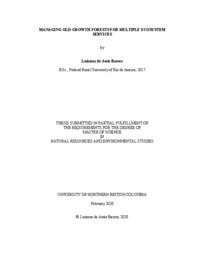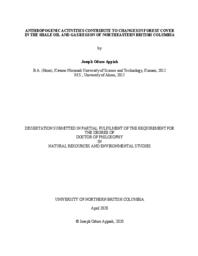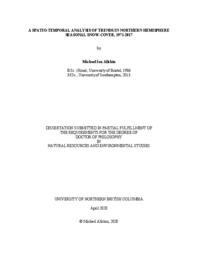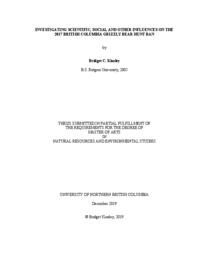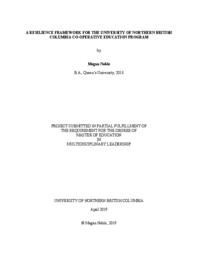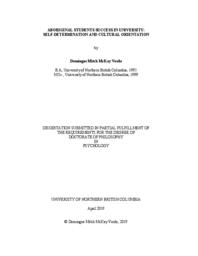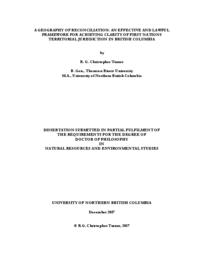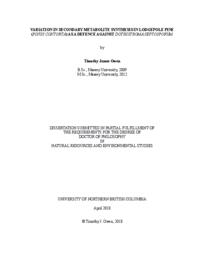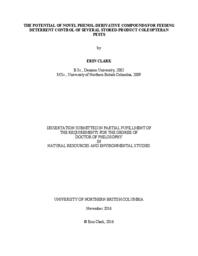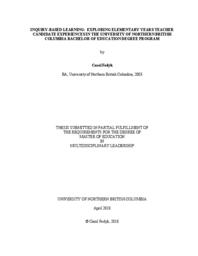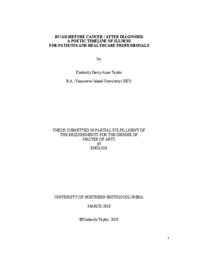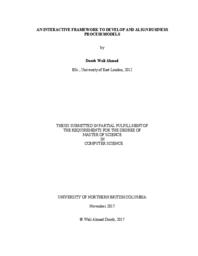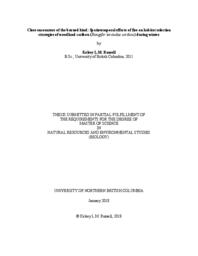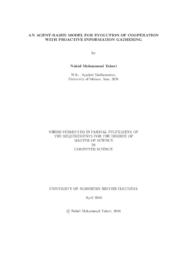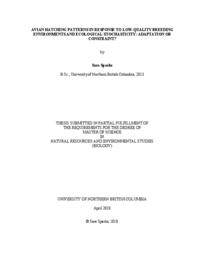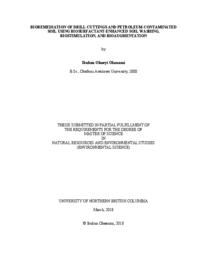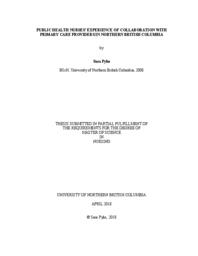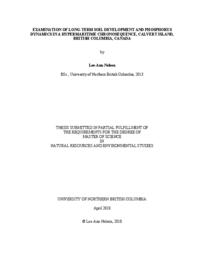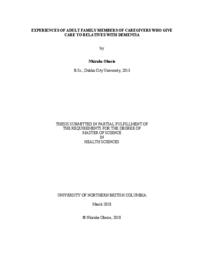University of Northern British Columbia
Related Works
Content type
Digital Document
Description / Synopsis
Old-growth forest reserves offer the potential to facilitate the maintenance of multiple ecosystem services (ES), such as carbon storage, water and recreation, in managed landscapes. However, substantial challenges exist with regard to defining and identifying old-growth forests, and suitably locating priority areas for old-growth conservation. To address these issues, I developed a structure-based old-growth index using field and LiDAR metrics that allowed old-growth values to be estimated at a fine grain across a landscape. I then used a spatial prioritization tool to simulate old-growth reserves for multiple ESs. Using this framework I evaluated trade-offs between forest ESs including timber. This thesis contributes to the management of old-growth forests by providing a quantitative and repeatable framework to identify, assess and monitor old-growth values while indicating the scope for the establishment of old-growth reserves for multiple ESs.
Origin Information
Content type
Digital Document
Description / Synopsis
The boreal forest ecosystems have been changing due to varying levels of anthropogenic land use processes such as logging, oil and gas activities, and agriculture. However, the cumulative impacts of these processes are likely to lead to a lasting degradation of the boreal forest ecosystem; and thus, contributing to environmental change. In this study, methods from Landscape Ecology, GIS, and remote sensing were used to process Landsat images and spatial data for shale gas infrastructure. These datasets and methods were used for measuring and assessing the forest change pattern in a study area in northeastern British Columbia (BC). The results of the study show that gross loss (5.98%) of coniferous forest cover in the timber harvest land base (THLB) is higher than the rate of gross loss (3.22%) of the coniferous forest cover in the area outside the THLB. However, the rate of net loss in coniferous forest cover is smaller in the THLB than that of outside the THLB (net loss THLB=0.6%; net loss non-THLB=1.7%). These dynamics in forest cover suggest that it is more likely for forest cover to regenerate much faster in the THLB than outside the THLB. The quantity of forest cover loss (0.163%) from shale oil and gas well pads development is more than the amount of forest loss from shale oil and gas access roads (0.017%) and pipeline development (0.057%). A higher amount of forest fragmentation is associated with periods and locations that have a high amount of anthropogenic-induced land classes in the landscape. These results of the study could serve as the information for modelling land change and fragmentation in the future. The finding from this study could assist land managers in the allocation of land uses across space as well as the formulation of effective and efficient policy frameworks and management initiatives.
Origin Information
Content type
Digital Document
Description / Synopsis
Ghana joined the league of oil and gas producing countries in 2007 when oil was discovered in the Gulf of Guinea. Through the years, however, concerns have emerged over the impacts of oil and gas activities on coastal livelihoods, especially since the benefits of extraction do not seem to trickle down to these communities. This thesis employs the Feminist Political Economy framework to examine the gendered disparities embedded in relations between offshore oil extraction and livelihoods of women in Ghana. Through an exploratory approach and a mixed methods design, I reveal how the intersection of culture, geography, politics, race and class foster the dispossession of coastal women. Among other findings, this thesis reveals that fishing is still the main source of livelihoods, and a culturally import source of food for the Western Region. It also shows that the advent of oil in the region has not improved but worsened women's livelihoods.
Origin Information
Content type
Digital Document
Description / Synopsis
Seasonal snow-cover (SSC) substantially alters surface physical properties over the Northern Hemisphere (NH). It modulates processes within the energy and water cycles, thereby influencing climatology, hydrology, geomorphology and ecology. In spring and summer, snowmelt provides an essential resource for humankind. The identification, quantification and explanation of changing spatial and temporal distributions of SSC helps to predict future impacts on natural and human environments, and informs development of mitigation and adaptation strategies. Because SSC is spatially and temporally heterogeneous, meaningful estimation of trends in its distribution and duration is dependent on long records of remotely-sensed imagery. The Rutgers University Global Snow Laboratory and the United States’ National Oceanic and Atmospheric Administration provide the longest such archive (NOAA-Rutgers Snow Archive, NRSA), dating from 1966. However, several studies have raised questions about the credibility of the signs and magnitudes of trends derived from the NRSA, suggesting that they may be artifacts of technological improvements introduced in 1999. This dissertation improves the spatial resolution at which NH SSC extent and duration trends during the NRSA’s longest continuous section (since 1971) are reported, building on previous hemispheric and continental studies. It demonstrates that the magnitudes of area-related trends are sensitive to assumptions adopted when estimating SSC extent from the NRSA, and that these sensitivities vary spatially. The study assesses whether temporal trajectories of SSConset trends imply abrupt changes in 1999, particularly over more complex terrain, and finds no evidence of this. It also explores the broader climatological contexts of these trends, together with estimated departures from mean conditions. Evidence is presented at monthly intervals for causative chains linking advection of mid-tropospheric warming from lower to higher latitudes, consequent inception of climatologically novel airflows, and the incidence of significant SSConset trends of both signs. Earlier onset of snow-dominated conditions is found to be driven by augmented moisture advected from lower latitudes (in eastern Eurasia) or zonally from oceanic sources (in North America) over regional monthly mean 0°C isotherms. Delayed onset is associated with drier or warmer airflows. These findings support the interpretation that the NRSA-based trends are plausible within their spatial and temporal contexts.
Origin Information
Content type
Digital Document
Description / Synopsis
British Columbia has the largest grizzly bear population in Canada. In 2017, B.C. banned the hunt of grizzly bears citing a lack of societal support, despite government-cited science that the hunt was sustainably managed. I explored the factors that influenced popular perceptions of grizzly bears, the hunt, how these factors may have influenced the province’s decision to implement the ban, and its reception by various actors. Methods included: examining key claims in government documents preceding the ban; surveying media coverage of the ban; and interviewing experts (n = 30) about their role in, and opinion of the ban. Results indicated that public perception of the hunt, and its framing as a trophy hunt outweighed scientific evidence of hunt sustainability. However, controversy over the representativeness of the “public opinion”, and comprehensiveness of government consultation processes remain. I suggest avenues for further research into roles of social values in natural resource policy.
Origin Information
Content type
Digital Document
Description / Synopsis
Suicide is a global health issue that involves the biological, social, cultural, spiritual, and psychological state of an individual in addition to many other factors which interact and lead a person to Suicidal Ideation (SI) and Suicide Attempt (SA). Over the last decade, with the advent of large medical databases, there has been a tremendous rise in the use of Business Intelligence (BI) in the healthcare sector. Healthcare uses BI tools to transform raw data into meaningful information to extract the potential value of historical data. Timely diagnoses of mental health problems can assist experts to address it at an early stage and enhance patient’s quality of life. There is a critical need to examine the fundamental psychological well-being issues among the worldwide population, which may develop into more complex issues, if not considered at an early period. This research focuses on two main components: Data visualization and Predictive model. First, a mental health dashboard is created using an end to end approach in which mental health data is pre-processed, integrated, and visualized in the form of several reports. These reports display the aggregated results in visually appealing formats (i.e., graphs, tables, pie charts, and line graphs) and allow navigation to finer granularity reports via drill down and drill through reports. Second, a predictive model is built to forecasts Suicide Attempts (SA). Ontario Mental Health Reporting System (OMHRS) database obtained from CIHI (Canadian Institute for Health Information) is used to train and test the predictive model. This model uses advanced data mining algorithms, including Artificial Neural Networks, Decision trees, and regression. The outcomes of different data mining algorithms are compared with actual values to determine the accuracy of the model. In addition, a web form is created, which takes input from the user and calculates the probability of SA for a given patient. The objective of this research is to provide a better understanding of trends, outliers, and patterns to enable healthcare providers to make more informed decisions and decrease mortality rate due to suicide.
Origin Information
Content type
Digital Document
Description / Synopsis
This project focused on fostering resilience amongst co-operative higher education students as a necessary skill for success in academia, the workforce, and in life. There are five chapters in this project. Chapter 1 outlines the significance, background, and purpose of the project, as well as my personal location as a researcher. Chapter 2 presents a thematic and study-by-study literature review that explores co-operative education and its models as well as ramifications of student resilience in higher education. The literature review identified major themes of academic, career, stress/emotional, and communication/social resilience common to co-operative higher education students. Chapter 3 discusses the research methods, which were based on an educational qualitative orientation and content and documentary research designs.
Origin Information
Content type
Digital Document
Description / Synopsis
This research used a mixed-method approach to examine motivational factors contributing to Aboriginal student retention at the University of Northern British Columbia. To explore academic motivation in the context of Self-Determination Theory, 20 Aboriginal participants completed in-depth interviews. The participants also completed an acculturation questionnaire to explore whether cultural orientation was an interceding factor in academic motivation. Five intriguing findings emerged from the data. First, Aboriginal students were motivated to succeed by the desire to contribute to the well-being of the participants’ home Aboriginal community, or to the broader Aboriginal community. Second, the participants viewed a university education as a means to self-growth, which they perceived as necessary to fulfill a needed role in the Aboriginal community. Third, home community support and institutional support were important factors in motivating students to stay in university and earn a degree. Fourth, participants perceived that their university experience supported their autonomy. Finally, in comparison with more acculturated participants, less acculturated participants were more likely to feel academically unprepared for university, were more likely to attend post-secondary education transition programs, were more likely to use academic resources at the university, and were more likely to return to their home Aboriginal community after graduation. This research showed that Self-Determination Theory, traditionally tested using quantitative methods, can be effectively explored using a qualitative approach. This research also showed that examining cultural orientation within a motivational framework contributes to our understanding of the influence of cultural dynamics on academic motivation in Aboriginal student populations.
Origin Information
Content type
Digital Document
Origin Information
Content type
Digital Document
Origin Information
Content type
Digital Document
Origin Information
Content type
Digital Document
Origin Information
Content type
Digital Document
Origin Information
Content type
Digital Document
Origin Information
Content type
Digital Document
Origin Information
Content type
Digital Document
Origin Information
Content type
Digital Document
Origin Information
Content type
Digital Document
Origin Information
Content type
Digital Document
Origin Information
Content type
Digital Document
Origin Information
Content type
Digital Document
Origin Information
Content type
Digital Document
Origin Information
Content type
Digital Document
Origin Information
Content type
Digital Document
Origin Information
Content type
Digital Document
Origin Information

